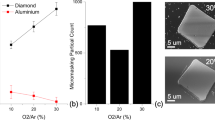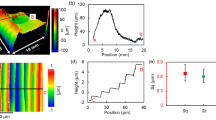Abstract
DIAMOND films prepared by chemical vapour deposition (CVD) have received considerable attention because of their high thermal conductivity, optical transparency, hardness, inertness and semiconducting properties1,2. The control of film geometry (by thinning, polishing, patterning and shaping) is essential for most applications. Polishing by reaction with oxygen gas or ions usually results in pitting at grain boundaries3,4, and other techniques5–8 are generally slow. Thinning or polishing of single-crystal diamond9 and CVD films4,10 by high-temperature diffusional reaction with solid transition metals has been reported previously. But these approaches require either a hydrogen atmosphere9, which is undesirable industrially, or high pressures (200–3,000 p.s.i.) during the heat treatment4,10. We report here a method for shaping and thinning which does not suffer from these limitations. It involves the use of molten rare-earth metals such as cerium or lanthanum to etch away the diamond film surface. Substantial thinning and shaping can be achieved in just a few hours. We anticipate that this technique may open up new applications of diamond films in optics and biomedicine.
This is a preview of subscription content, access via your institution
Access options
Subscribe to this journal
Receive 51 print issues and online access
$199.00 per year
only $3.90 per issue
Buy this article
- Purchase on Springer Link
- Instant access to full article PDF
Prices may be subject to local taxes which are calculated during checkout
Similar content being viewed by others
References
Angus, J. C. et al. A. Rev. Mater. Sci. 21, 221–248 (1991).
Graebner, J. E. et al. Nature 359, 401–403 (1992).
Harker, A. B. in Applications of Diamond Films and Related Materials (eds Tzeng, Y. et al.) 223–225 (Elsevier, New York, 1991).
Jin, S. et al. Diamond Related Mater. 1, 949–953 (1992).
Hirata, A. et al. in Applications of Diamond Films and Related Materials (eds Tzeng, Y. et al.) 227–232 (Elsevier, New York, 1991).
Tokura, H. & Yoshikawa, M. in Applications of Diamond Films and Related Materials (eds Tzeng, Y. et al.) 241–248 (1991).
Yoshikawa, M. Diamond Films Technol. 1, 1–29 (1991).
Silveri, P. Indust. Diamond Rev. 46, 108–109 (1986).
Grigoriev, A. P. & Kovalsky, V. V. Indiaqua 39, 47–54 (1984).
Jin, S. et al. Appl. Phys. Lett. 60, 1948–1950 (1992).
Graebner, J. E. et al. Appl. Phys. Lett. 60, 1576–1578 (1992).
Binary Alloy Phase Diagrams, 2nd Edn (eds Massalski, T. B.) 834 (ASM International, Metals Park, Ohio, 1990).
Binary Alloy Phase Diagrams, 2nd Edn (eds Massalski, T. B. et al.) 856 (ASM International, Metals Park, Ohio, 1990).
Author information
Authors and Affiliations
Rights and permissions
About this article
Cite this article
Jin, S., Graebner, J., McCormack, M. et al. Shaping of diamond films by etching with molten rare-earth metals. Nature 362, 822–824 (1993). https://doi.org/10.1038/362822a0
Received:
Accepted:
Issue Date:
DOI: https://doi.org/10.1038/362822a0
This article is cited by
-
Thermochemical material removal of diamond by solid iron and mischmetal
Production Engineering (2009)
-
Chemical vapor deposited diamond for thermal management
JOM (1998)
-
Processing and properties of CVD diamond for thermal management
Journal of Electronic Materials (1998)
Comments
By submitting a comment you agree to abide by our Terms and Community Guidelines. If you find something abusive or that does not comply with our terms or guidelines please flag it as inappropriate.



